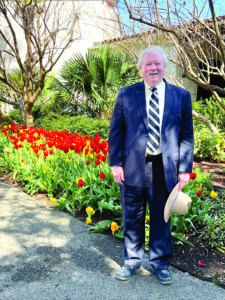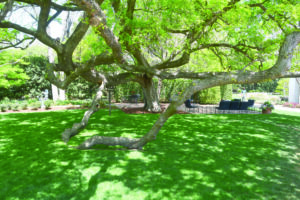By Judy Babb
Peter Flagg Maxson sits comfortably relaxed in a conference room at the DeGolyer Estate, looking like he owns the place. Reality is, he could have been part owner if his grandparents Everette L. DeGolyer and Nell Goodrich DeGolyer had decided to leave the estate to their four children and 16 grandchildren. But that was the so-called problem — too many people to split the 44 acres.
Maxson said with a twinkle in his eye that they should have left it to him since he was the favorite of the grandchildren.

Photo by Judy Babb
“If she and grandfather had not been so thoughtless as to have four children and 16 grandchildren, three rare books collections and a foundation, I’m sure I might be living here today,” he quipped.
Instead, the DeGolyers donated the house and property to Southern Methodist University. The university took the books and created The DeGolyer Library. The university later sold the White Rock Lake property to the City of Dallas for $1 million. That property became the Dallas Arboretum. The current park has grown to 66 acres with the accrual of the Camp property next door.
Maxson spent much of his young life at the DeGolyer estate. “When I was very young, it was something I took very much for granted,” Maxson said. “I didn’t realize until about third grade that not everyone’s grandparents lived in such splendor.”
“We just very much looked at it all as the family home,” he said. “As young kids, we’d splash around in the octagonal fountain.” He remembered eating at a dining room table that, when fully extended, could seat 30 people.
He remembered playing there and having his 21st, 50th and now 75th birthdays hosted on the property. His coming-of-age party when he turned 21 was one he had to badger his grandmother to have. “The only time I sat at the head of the table was my 21st birthday,” Maxson said. He had to browbeat his grandmother Nell to host that party.
Nell fostered Maxson’s love of history and architecture. She started his collection of architectural books when he was 12. And his love of fine things was nurtured by his grandparents. “When other kids wanted baseball bats, I wanted a Chippendale table,” Maxson said. He got it and still has it in his circa 1896 home in Austin.
The estate was originally a 44-acre dairy farm. His grandfather, who everyone called De, and his grandmother loved the magnificent trees and the lake views. They bought the property and hired two brothers from California to design the home.

Photo courtesy of the Dallas Arboretum
The DeGolyers traveled up and down the California coast acquiring ideas and objects they wanted in their home, which turned out to be unique in Dallas as they based much of what they wanted from California. They called it Rancho Encino. The house is now the centerpiece of the Dallas Arboretum.
Maxson returns to the arboretum occasionally during the year and always in November. He visits with the docents and sometimes makes corrections to their stories about the house and the property. There is a baptismal font in the foyer that came from California. One of the docents had been telling people that Henry VIII had been baptized in it. In his gentle manner, he corrected the misinformation. On other occasions, a correction would be met with a docent asking, “Are you sure?” Yes, he was.
Maxson, as an architectural historian, was responsible for the DeGolyer Estate getting its historical marker as he has many other places in Texas. He explained there are two types of historical makers.
The first is an object marker. Primarily, it records events. He had one such sign erected in Waco to document a Crash at the Crush, which was an odd and deadly event planned to demonstrate to people what a train crash is like. Two trains and 12 cars were staged to run into each other at a high rate of speed (estimated at more than 45 mph). The boilers on both engines exploded, two people were killed, and six were seriously.
The other kind of marker is a building marker. Maxson explained the buildings recorded as Texas landmarks were chosen for their age, integrity and significance. “I did evaluations of those properties in my historical commission days and then later as a consultant,” he said. The building marker is the one he attained for the DeGolyer estate.
While Maxson no longer works for the historical commission, he does occasional consultant jobs. “I’d be hired by people,” he said. “for instance, the late Virginia McAlister, who is great preservationist herself.” She inherited her grandparent’s home on Swiss Avenue and hired Maxson to research it. “I felt very flattered,” Maxson said. “She’d done books on architectural history and she hired me to document her family home.”
Maxson retired from the historical commission in 1989. “I’d gone as far as I could go in being able to do research and writing.” He wasn’t interested in going into administration. They gave him the Meritorious Service Award for his work.
Maxson is hardly through with his work as an architectural historian. “I’ve seriously been thinking about doing a book on the DeGolyers and their homes. I think it would be fun,” Maxson said. “After 75 trips around the sun, I realized there is stuff that really needs to be put on paper.”
